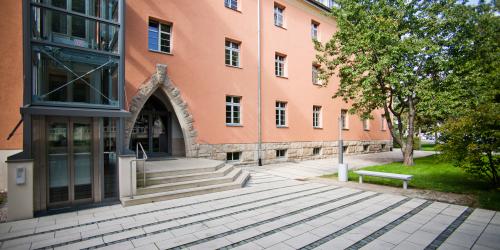
Jena's traffic benefits from the innovative 5G project
How can the situation for all road users in the city be improved with the help of the 5G mobile network? Answers to this question have been developed in Jena since the beginning of 2021 in the pilot project "5G traffic networking". As the joint project, funded by the federal government with a total of 3.9 million euros, ends in June for the city of Jena, today's final meeting will focus on evaluations and outlooks.
In addition to digitalization department head Benjamin Koppe, Smart City overall project manager Dorothea Prell and "5G Traffic Networking" project manager Heike Stötzner, partners from the regional economy in Thuringia and Saxony (Data in Motion, INAVET), from research institutions (TU Dresden, Mittweida University of Applied Sciences) and from municipal companies (Kommunalservice Jena, Stadtwerke Jena Netze, Jenaer Nahverkehr) are on site.
Comprehensive coverage with state-of-the-art mobile communications technology
5G is the fifth generation of mobile communications and differs from the older 4G (or LTE) network technology primarily in terms of data transmission speed. Thanks to the project, Jena was able to provide nationwide coverage with 5G mobile technology at an early stage - even before cities such as Erfurt. "The declared aim of the 5G innovation program of the Federal Ministry for Digital and Transport (BMDV) is to promote 5G implementation here in Jena. Thanks to the project, we were able to prioritize the expansion of the 5G network in the city at an early stage. With the help of this 5G mobile communications standard, we have tested real-time communication here on site and implemented individual use cases," reports Benjamin Koppe, the department head responsible for digitalization.
Innovative results to be applied in real operations
The city can benefit not only from the network expansion, but also from the knowledge gained in the future. "We have a great interest in continuing to use the innovative results from various sub-projects after the end of the implementation project," emphasizes overall project manager Prell.
Central data instance for traffic data is the centerpiece
At the heart of the project is a central data instance (data broker), which receives, models and analyzes all traffic-relevant data from the project in compliance with data protection regulations and makes it available to the developed applications in real time. The data broker summarizes all event and sensor data from the urban area and is part of the urban data platform developed in the Smart City project. "By developing a central data instance that processes different traffic data - for example from traffic lights and streetcars - we have created a basis for the 5G-based networking of all types of road users in the project, including public transport, motorized private transport, cycling and pedestrian traffic," says department head Koppe.
Sub-project for optimized traffic flow
The aim of the "cooperative traffic light system" sub-project is to optimize the flow of traffic - for all road users. A test section was set up by Kommunalservice Jena between the Volksbad and Fischergasse traffic junctions, which are equipped with special cameras. The data recorded in the traffic flow is made available via the data broker. A control system based on artificial intelligence developed in the project is being tested to optimize the traffic light phases. The aim is to adjust the traffic lights every second so that the waiting time in busy areas is optimized for all road users - while at the same time ensuring a high level of traffic safety. The municipal company Kommunalservice Jena has been intensively involved in this sub-project from the very beginning.
Sub-project for optimized load and feed-in flows
Stadtwerke Jena Netze and Jenaer Nahverkehr are closely involved in the "load management system" sub-project. One aim is to optimize the charging processes of the e-buses in the depot. Values such as voltage, current and power can be transmitted via 5G during operation. This makes it possible to estimate what power is available for charging the e-buses at what time. In this way, the charging equipment for e-buses connected to the transformer station can release the optimum power without unnecessarily overloading the transformer station or limiting the charging power of the e-bus too much.
Optimum control of energy consumption is also important for streetcars, as load peaks occur particularly during acceleration. The project partners are developing a driver assistance system that provides drivers with specific information when they are on the move in order to avoid selective overloads in the power grid by adapting their driving style. This newly developed driver assistance system can be tested and trained by employees of Jena's public transport system at a driver's station developed and funded by the project.
Conclusion: Significantly better data and long-term use
Once the pilot project has been completed, the city of Jena will benefit from the new systems. "Some of the use cases will contribute to a significant improvement in our data situation in the future, for example in traffic monitoring, and will be integrated into our Smart City project and driven forward," summarizes project manager Prell. "The newly developed systems for multimodal control of traffic lights or for more efficient control of e-bus charging processes can continue to be used by Kommunalservice Jena and Jena's public transport system. A big thank you goes to all project partners, but especially to our municipal partners and companies here on site, who have made a decisive contribution to the successful implementation of our project goals with their professional and technical expertise and their knowledge of the conditions in the city."
